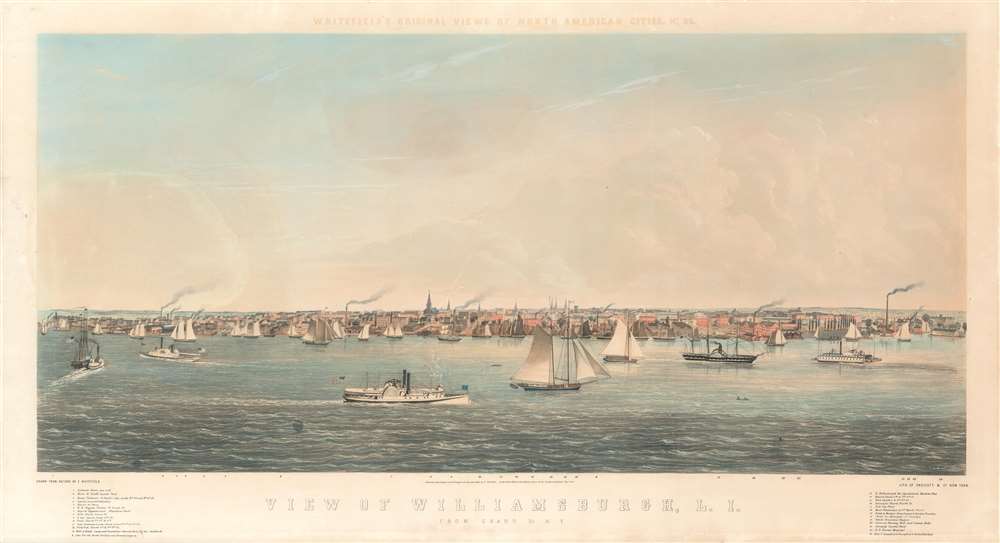1852 Whitefield View of Williamsburg, Brooklyn
WilliamsburgBrooklyn-whitefield-1852
Title
1852 (dated) 19.5 x 35.5 in (49.53 x 90.17 cm)
Description
Gentrifying Williamsburg
In the years prior to World War II, Williamsburg became a center for Jewish migration. This trend only increased in the 1940s and 1950s, when refugees and Holocaust survivors flooded into Williamsburg from Hungary and Romania. Williamsburg rapidly became the largest Jewish community outside of Israel. From about 1990, Williamsburg north of Broadway became a center of gentrification and art-culture. Drawn by proximity to Manhattan, large loft spaces, and low rents, Williamsburg was flooded by artists and scrappy alternative-culture youth. This ultimately led to skyrocketing real-estate prices and large-scale gentrification. Nonetheless, Williamsburg remains a haven for artists and other creatives, and is considered one of New York City's most interesting, diverse, and vibrant neighborhoods. The southern part of Williamsburg remains a conservative Jewish enclave.Chromolithography
Chromolithography is a color lithographic technique developed in the mid-19th century. The process involved using multiple lithographic stones, one for each color, to yield a rich composite effect. Oftentimes, the process would start with a black basecoat upon which subsequent colors were layered. Some chromolithographs used 30 or more separate lithographic stones to achieve the desired effect. Chromolithograph color could also be effectively blended for even more dramatic results. The process became extremely popular in the late 19th and early 20th centuries, when it emerged as the dominate method of color printing. The vivid color chromolithography produced made it exceptionally effective for advertising and propaganda imagery.Publication History and Census
This view was published by Isaac Prindle of Brooklyn and engraved and printed by Endicott and Company of New York based upon Whitefield's original artwork. It is view no. 26 in Whitefield's Original Views of North American Cities, a loose leaf issued on a subscription basis. This view is quite rare. We are aware of examples at the New York Public Library and at the New York City Historical Society.CartographerS
Edwin Whitefield Pennie (September 22, 1816 - December 26, 1892) was an English-American landscape painter active in the middle part of the 19th century. Whitefield was born in East Lulworth, England, the son of a Dorset schoolmaster. He emigrated to America, probably Canada, in 1835, leaving his first wife (Maria) and son in England. Some speculate that the move may been motivated by unwanted pressure from his family to embrace onerous medical or legal work. He taught school in Canada, and there married again, taking a second wife, Kate, who was probably one of his students. Seeking to develop as an artist, he moved to the United States around 1837 or 1838, establishing himself as an itinerant traveler/artist/journalist. He travelled up and down the Hudson, creating views of various American cities along the river, doing commission work, and selling lithographs of his work by subscription. This turned into a series of views of North American cities, of which there were at least 37, possibly more. Among the cities in his portfolio are views of Brooklyn, Toronto, Quebec City, Montreal, Ithaca, Jamestown, Poughkeepsie, Williamsburg (Brooklyn), Niagara, Philadelphia, Salem, Albany, and Boston, among many others. He separated from Kate, his Canadian wife, in 1853. Whitefield moved to Minnesota in 1856, settling in Kandotta with a new wife, Lillian, to engaged in land speculation. He had some success there, where Whitefield township, established in 1870, was named after him. Nearby Lake Lillian is named after his third American wife. He briefly lived in Chicago around 1861, before moving to Reading, Massachusetts in 1863 to paint the historic homes of New England, a project that he obsessed over until 1889, when the three-volume Homes of our Forefathers was finally published. In addition to his views, Whitefield is said to have published maps (we have not identified any), playing cards, and patented the Notosericum embroidery stamping technique. Whitefield returned to England in 1888, but returned to Massachusetts in 1892, settling in Roslindale, then in Dedham, where he died. More by this mapmaker...
Endicott and Company (fl. c. 1828 - 1891) was a New York based family run lithography firm that flourished throughout the 19th century. The firm was founded by George and William Endicott, brothers who were born in Canton, Massachusetts. George Endicott (June 14, 1802 - 1848) trained as a lithographer under Pendleton Lithography from January 1826. He later worked as superintendent of Senefelder Company until the summer of 1828. Afterwards, in 1830, he relocated to Baltimore and partnered with Moses Swett. Endicott and Swett relocated to New York City in December 1831. They remained partners until July 1834 when the relationship dissolved. George set up shop on his own account at 359 Broadway. William Endicott (1815 - 1851), George's younger brother of 14 years, joined the firm in 1840 and was made a partner in 1845, after which the name of the firm was changed to G. and W. Endicott. George Endicott died shortly afterward, in 1848, but William continued operating the firm as William Endicott and Co. until his own 1851 death at just 35 years old. The firm was carried on by his widow Sara Munroe Endicott until it was taken over by her son, Francis Endicott, who ran the firm from 1852 to 1886. George Endicott, Jr. subsequently ran the firm from 1887 to 1891. Peters, in his important work on American lithography America on Stone writes 'it is hard to summarize the Endicotts. They did everything and did it well . . . [they] worked with and for Currier and Ives, yet in spite of all that much of their work lacks real individuality.' The Endicott firm was responsible for many 19th century views and plans of New York City and state as well as plans of Sacramento, California, and the Midwest. Learn More...

